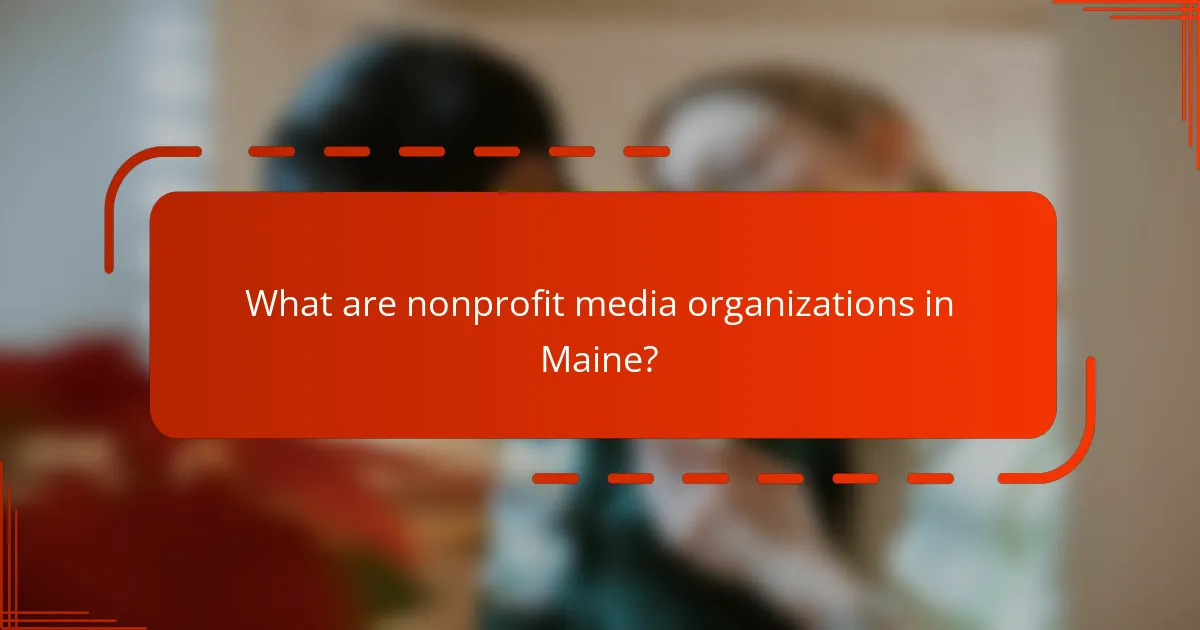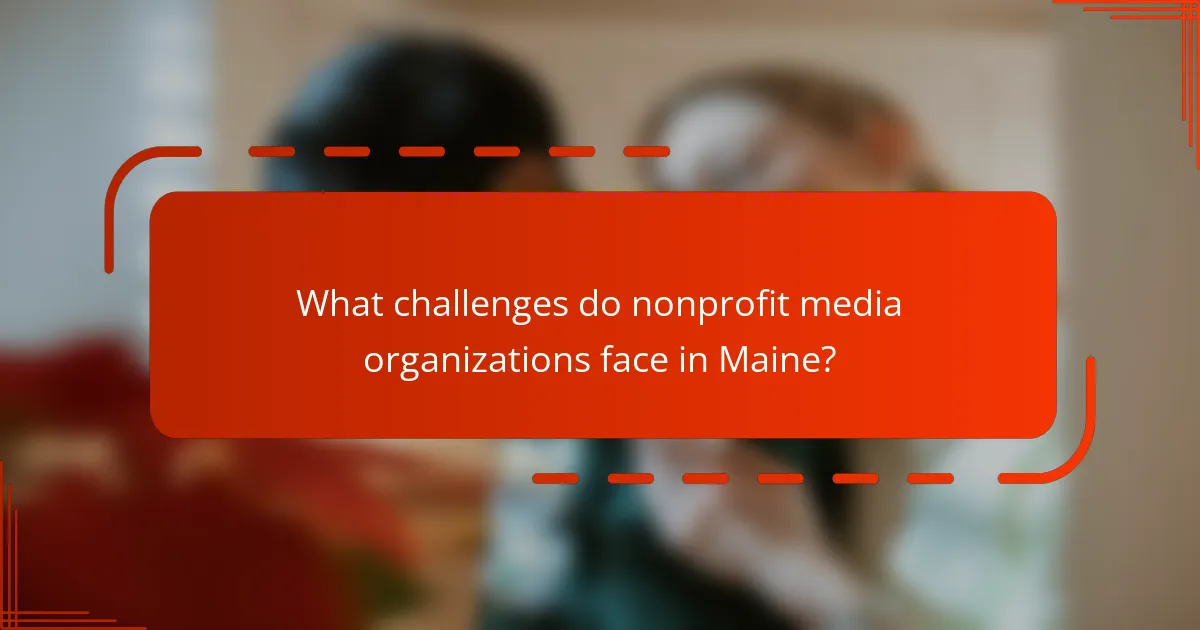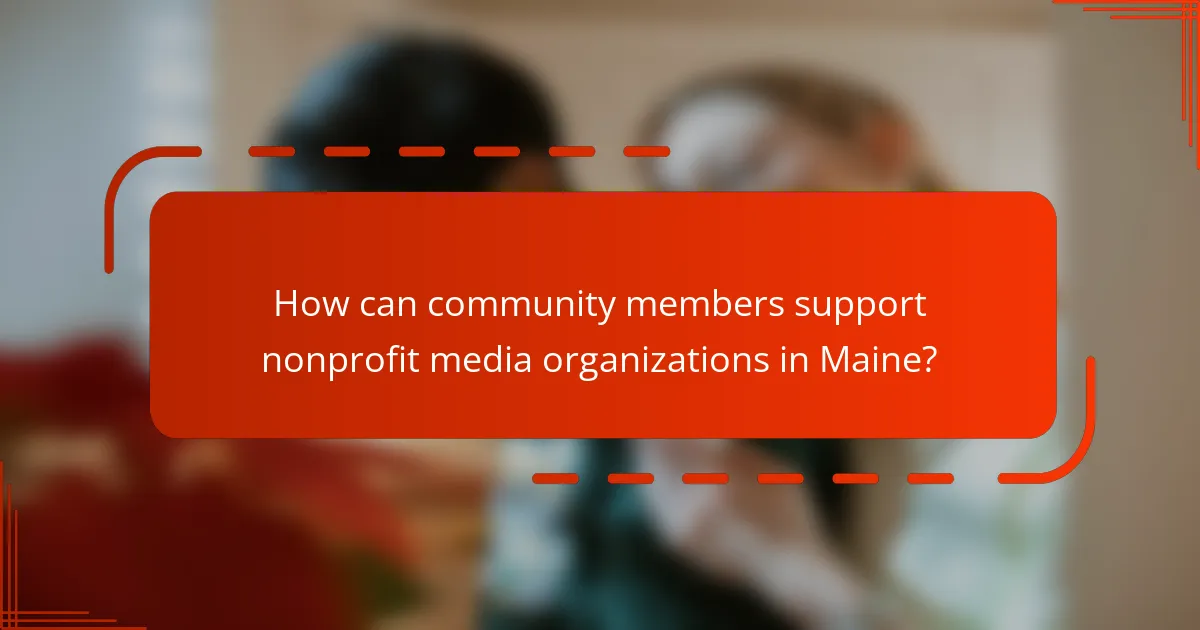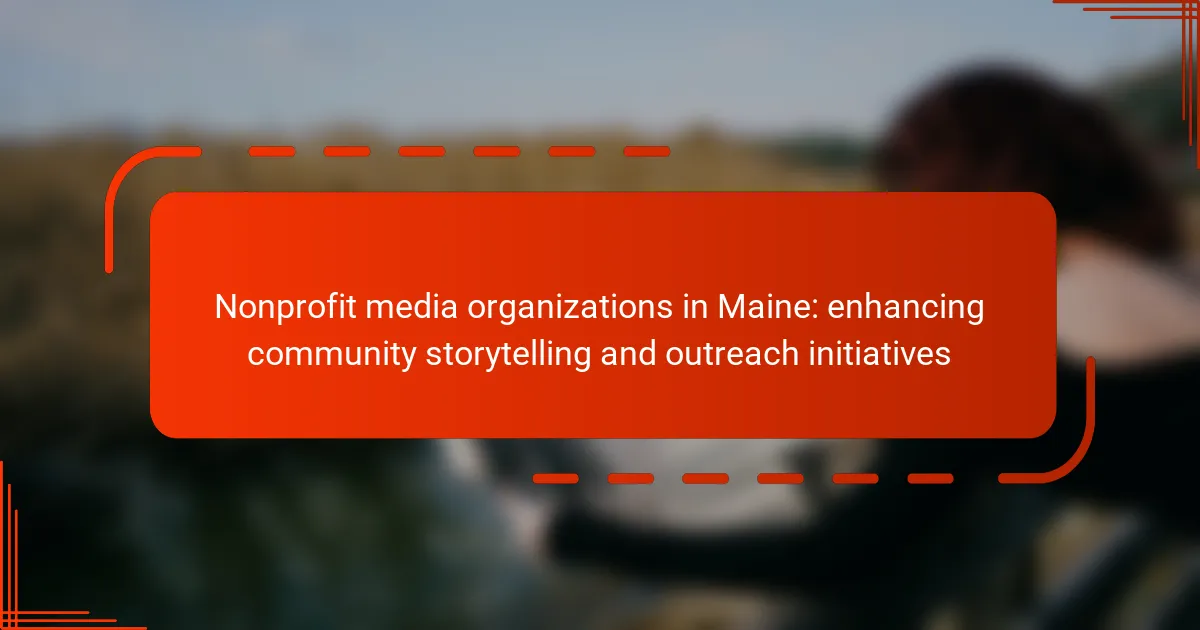Nonprofit media organizations in Maine are entities dedicated to producing news and information aimed at serving the public interest rather than generating profit. These organizations, such as Maine Public and Bangor Daily News, focus on local stories and community engagement while facing challenges like unpredictable funding, competition for resources, and digital transformation. Community support is vital for their sustainability, with opportunities for involvement including volunteering, donating, and engaging with content. This article examines the role of nonprofit media organizations in enhancing community storytelling and outreach initiatives, highlighting both their impact and the obstacles they encounter.

What are nonprofit media organizations in Maine?
Nonprofit media organizations in Maine are entities that produce news and information without the goal of making a profit. They focus on serving the public interest, often emphasizing local stories and community engagement. These organizations typically rely on funding from donations, grants, and community support. Examples include Maine Public, which provides radio and television programming, and the Bangor Daily News, which has a nonprofit model for certain initiatives. Nonprofit media organizations play a crucial role in enhancing community storytelling and outreach initiatives by providing diverse perspectives and fostering informed citizenry.
How do nonprofit media organizations contribute to community storytelling?
Nonprofit media organizations contribute to community storytelling by providing platforms for local voices and narratives. They amplify underrepresented stories that reflect community values and experiences. These organizations often focus on issues relevant to their communities, such as social justice, education, and health. For example, nonprofit outlets may cover local events that mainstream media overlook. They engage community members through participatory journalism, allowing residents to share their perspectives. This fosters a sense of ownership and connection among community members. Furthermore, nonprofit media often collaborate with local organizations to address specific community needs. Their work enhances civic engagement and promotes informed public discourse.
What types of stories do nonprofit media organizations focus on?
Nonprofit media organizations focus on community-centric stories. These stories often highlight local issues, social justice, and underserved populations. They aim to amplify voices that are typically marginalized in mainstream media. Nonprofit media also covers topics such as environmental concerns, education, and health disparities. Investigative journalism is a significant focus, aiming to uncover truths that impact communities. These organizations prioritize transparency and accountability in their reporting. They often collaborate with community members to ensure accurate representation. This approach fosters engagement and promotes civic participation among local residents.
How do these organizations engage with local communities?
Nonprofit media organizations in Maine engage with local communities through various outreach initiatives. They host community events to foster dialogue and collaboration. These organizations provide platforms for local voices and stories. They often partner with schools and community groups for educational programs. Workshops and training sessions are conducted to enhance media literacy. Surveys and feedback mechanisms are utilized to understand community needs. By producing localized content, they address specific issues relevant to the community. This engagement strengthens community ties and promotes active participation in media creation.
Why are nonprofit media organizations important for outreach initiatives?
Nonprofit media organizations are crucial for outreach initiatives because they provide unbiased information and amplify community voices. They focus on local issues that mainstream media may overlook. This enhances civic engagement and promotes informed decision-making. Nonprofit media often prioritize public interest over profit, ensuring diverse perspectives are represented. Research shows that communities with active nonprofit media report higher levels of civic participation. They also foster collaboration among local organizations, creating a network for shared resources and knowledge. This collaborative approach strengthens community bonds and encourages collective action.
What role do they play in promoting local issues?
Nonprofit media organizations in Maine play a crucial role in promoting local issues. They provide a platform for community voices and concerns. These organizations focus on storytelling that reflects local culture and challenges. They often cover topics that mainstream media may overlook. By doing so, they raise awareness about important community matters. They engage residents through interactive initiatives and discussions. Their reporting can influence local policy and decision-making. Research shows that such organizations increase civic engagement and public discourse.
How do they differ from for-profit media organizations?
Nonprofit media organizations differ from for-profit media organizations primarily in their funding and mission. Nonprofit media relies on donations, grants, and community support rather than advertising revenue. This funding model allows them to focus on community-oriented journalism and public service. For-profit media, on the other hand, prioritizes profit generation and often tailors content to attract advertisers. Nonprofit organizations emphasize transparency, accountability, and serving the public interest. According to the Pew Research Center, nonprofit media often covers underreported issues and provides diverse perspectives that for-profit entities may overlook.

What challenges do nonprofit media organizations face in Maine?
Nonprofit media organizations in Maine face several significant challenges. Funding is a primary obstacle, as many rely on grants and donations that can be unpredictable. Competition for these limited resources is intense among various nonprofits. Additionally, maintaining audience engagement is difficult in a rapidly changing media landscape. Many organizations struggle with digital transformation and adapting to new technologies. Staffing issues also arise, as attracting and retaining skilled journalists can be challenging due to budget constraints. These factors collectively hinder the ability of nonprofit media organizations to deliver consistent and impactful community storytelling.
How do funding and resources impact their operations?
Funding and resources significantly impact the operations of nonprofit media organizations in Maine. Adequate funding allows these organizations to hire skilled staff and invest in quality equipment. This investment enhances their ability to produce high-quality content. Resources also determine the scope of outreach initiatives. Limited funding can restrict their ability to reach diverse communities. Moreover, financial support enables partnerships with local entities for collaborative storytelling. In contrast, insufficient resources may lead to reduced programming and diminished audience engagement. Overall, funding and resources are crucial for sustaining operations and fulfilling their mission.
What are common funding sources for these organizations?
Common funding sources for nonprofit media organizations include grants, donations, and sponsorships. Grants are often provided by foundations, government agencies, and nonprofit organizations. Donations typically come from individuals and local businesses who support community initiatives. Sponsorships may be secured from corporations looking to enhance their community engagement. Additionally, some organizations generate revenue through membership fees and fundraising events. These funding sources are crucial for sustaining operations and supporting outreach initiatives in Maine’s nonprofit media landscape.
How can organizations overcome resource limitations?
Organizations can overcome resource limitations by leveraging partnerships and collaborations. These partnerships can provide access to shared resources and expertise. For example, nonprofits often collaborate with local businesses for funding or in-kind donations. Additionally, organizations can utilize volunteer support to expand their capacity. Volunteers can offer skills and time that reduce operational costs.
Implementing technology can also streamline processes and reduce expenses. For instance, using digital tools for communication and project management can enhance efficiency. Furthermore, organizations can pursue grant opportunities to secure additional funding. Many foundations provide financial support specifically for community initiatives.
Lastly, focusing on community engagement can increase local support and resources. Engaged communities are more likely to contribute time, money, and resources. By adopting these strategies, organizations can effectively navigate and overcome resource constraints.
What strategies can nonprofit media organizations use to enhance storytelling?
Nonprofit media organizations can enhance storytelling by utilizing community engagement strategies. Engaging local audiences fosters connections and encourages participation. This can include hosting workshops to gather personal stories from community members. Collaboration with local artists and writers can also enrich narratives. Leveraging social media platforms allows for broader outreach and interaction. Utilizing multimedia formats, such as podcasts and videos, can make stories more compelling. Data-driven storytelling can provide context and relevance to issues affecting the community. According to a report by the Knight Foundation, organizations that prioritize community involvement see increased audience loyalty and impact.
How can technology improve outreach and engagement?
Technology can improve outreach and engagement by facilitating communication and expanding reach. Digital platforms enable nonprofits to connect with wider audiences effectively. Social media tools allow organizations to share stories and updates in real-time. Email marketing software helps in targeting specific demographics with personalized messages. Analytics tools provide insights into audience behavior and preferences. Mobile applications enhance accessibility and engagement through notifications and interactive content. Video conferencing tools foster community discussions and feedback. Research shows that organizations using technology for outreach see increased participation and support. For instance, a report by the Nonprofit Technology Network indicates that 70% of nonprofits using social media experienced improved engagement.
What partnerships can strengthen their community presence?
Collaborations with local schools can strengthen community presence for nonprofit media organizations. These partnerships facilitate educational programs and workshops. Engaging students fosters media literacy and storytelling skills. Collaborating with local businesses enhances visibility and support. Businesses can sponsor events or provide resources. Partnerships with health organizations can promote community wellness initiatives. These collaborations can lead to informative content addressing public health issues. Additionally, working with cultural institutions can amplify diverse voices in storytelling. This approach enriches community narratives and fosters inclusivity.

How can community members support nonprofit media organizations in Maine?
Community members can support nonprofit media organizations in Maine by volunteering their time and skills. Many organizations seek help with writing, editing, and production. Donations are also crucial for financial sustainability. Community members can contribute funds or resources, ensuring operational costs are covered. Engaging with content by sharing articles on social media increases visibility. Attending events hosted by these organizations fosters community involvement and support. Providing feedback on content helps organizations improve their offerings. Collaborating on local projects can enhance storytelling initiatives. These actions collectively strengthen the nonprofit media landscape in Maine.
What are effective ways for individuals to get involved?
Individuals can get involved with nonprofit media organizations in Maine by volunteering their time and skills. Many organizations seek volunteers for various roles, including writing, editing, and event planning. Individuals can also participate in community events organized by these nonprofits. Attending workshops or forums hosted by these organizations fosters engagement and learning. Donating funds or resources supports their initiatives and operational costs. Additionally, individuals can advocate for these organizations through social media and word-of-mouth. Engaging with local storytelling projects enhances community connections and promotes shared narratives. These actions collectively strengthen the impact of nonprofit media organizations in Maine.
How can volunteering benefit both the organization and the volunteer?
Volunteering benefits both the organization and the volunteer through skill development and resource enhancement. Organizations gain access to diverse skills and perspectives from volunteers. This can lead to improved services and innovative programs. Volunteers, in turn, develop new competencies and gain practical experience. They often build valuable networks and enhance their resumes. Research shows that 70% of volunteers report increased self-esteem and confidence. This mutual benefit strengthens community ties and fosters a culture of collaboration.
What role does financial support play in sustaining these organizations?
Financial support is essential for sustaining nonprofit media organizations. These organizations rely on funding to cover operational costs, including staff salaries, equipment, and production expenses. Financial backing enables them to produce quality content that serves community interests. It also allows for the development of outreach initiatives that engage local audiences. In Maine, many nonprofit media organizations depend on grants, donations, and sponsorships to maintain their services. According to the Maine Nonprofit Association, approximately 70% of nonprofit funding comes from private contributions, highlighting the importance of financial support in their sustainability. Without adequate funding, these organizations may struggle to fulfill their mission of enhancing community storytelling.
What best practices should nonprofit media organizations adopt for success?
Nonprofit media organizations should adopt transparency, community engagement, and diverse funding strategies for success. Transparency builds trust with audiences and stakeholders. Engaging the community fosters relevant content and strengthens local ties. Diverse funding sources, such as grants, donations, and partnerships, ensure financial stability. Collaboration with other organizations enhances resource sharing and outreach. Utilizing digital platforms increases visibility and audience reach. Training staff in multimedia skills improves content quality and adaptability. Regularly evaluating impact helps organizations adjust strategies effectively. These practices support sustainable growth and community relevance.
How can they measure their impact on the community?
Nonprofit media organizations in Maine can measure their impact on the community through various methods. They can conduct surveys to gather feedback from community members regarding their programs and initiatives. Analyzing engagement metrics, such as website traffic and social media interactions, provides insights into audience reach. Collaborating with local organizations for joint events allows for measuring attendance and community involvement. Tracking the number of stories published that reflect community issues can indicate relevance and engagement. Additionally, assessing changes in community awareness or attitudes through pre- and post-campaign studies can quantify impact. These methods help establish a clear understanding of the organization’s contribution to the community.
What innovative approaches can enhance their storytelling efforts?
Utilizing multimedia elements can enhance storytelling efforts for nonprofit media organizations. This includes integrating video, audio, and interactive graphics. These elements can engage audiences more effectively than text alone. Research indicates that stories with visual content receive 94% more views than those without. Collaborating with local artists can also provide unique perspectives and creativity. This partnership can strengthen community ties and enrich narratives. Additionally, leveraging social media platforms can broaden reach and encourage audience interaction. Engaging the community in storytelling processes fosters inclusivity and diverse voices. These innovative approaches can significantly improve storytelling effectiveness and community impact.
Nonprofit media organizations in Maine are entities dedicated to producing news and information aimed at serving the public interest rather than generating profit. This article explores their role in enhancing community storytelling and outreach initiatives, highlighting how they focus on local issues, engage with community members, and provide platforms for underrepresented voices. It discusses the challenges these organizations face, including funding limitations and audience engagement, while outlining strategies for effective storytelling and community involvement. Additionally, it emphasizes the importance of financial support and innovative approaches to sustain their operations and impact.
